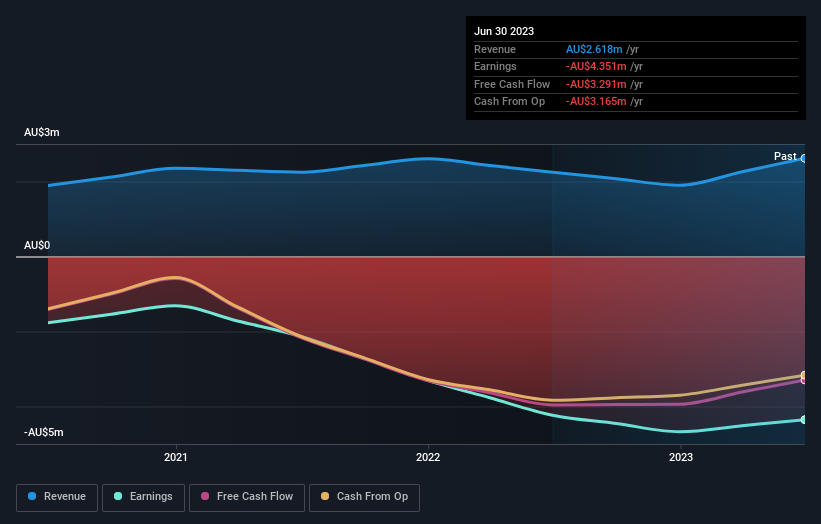Investors ignore increasing losses at Optiscan Imaging (ASX:OIL) as stock jumps 43% this past week
Stock pickers are generally looking for stocks that will outperform the broader market. And while active stock picking involves risks (and requires diversification) it can also provide excess returns. For example, the Optiscan Imaging Limited (ASX:OIL) share price is up 69% in the last 5 years, clearly besting the market return of around 18% (ignoring dividends).
The past week has proven to be lucrative for Optiscan Imaging investors, so let's see if fundamentals drove the company's five-year performance.
See our latest analysis for Optiscan Imaging
Optiscan Imaging isn't currently profitable, so most analysts would look to revenue growth to get an idea of how fast the underlying business is growing. Shareholders of unprofitable companies usually expect strong revenue growth. As you can imagine, fast revenue growth, when maintained, often leads to fast profit growth.
For the last half decade, Optiscan Imaging can boast revenue growth at a rate of 2.7% per year. That's not a very high growth rate considering the bottom line. While it's hard to say just how much value the company added over five years, the annualised share price gain of 11% seems about right. We'd be looking for the underlying business to grow revenue a bit faster.
The graphic below depicts how earnings and revenue have changed over time (unveil the exact values by clicking on the image).
We like that insiders have been buying shares in the last twelve months. Having said that, most people consider earnings and revenue growth trends to be a more meaningful guide to the business. Before buying or selling a stock, we always recommend a close examination of historic growth trends, available here..
What About The Total Shareholder Return (TSR)?
Investors should note that there's a difference between Optiscan Imaging's total shareholder return (TSR) and its share price change, which we've covered above. The TSR attempts to capture the value of dividends (as if they were reinvested) as well as any spin-offs or discounted capital raisings offered to shareholders. Optiscan Imaging hasn't been paying dividends, but its TSR of 73% exceeds its share price return of 69%, implying it has either spun-off a business, or raised capital at a discount; thereby providing additional value to shareholders.
A Different Perspective
Optiscan Imaging shareholders are down 2.4% for the year, but the market itself is up 1.1%. Even the share prices of good stocks drop sometimes, but we want to see improvements in the fundamental metrics of a business, before getting too interested. Longer term investors wouldn't be so upset, since they would have made 12%, each year, over five years. If the fundamental data continues to indicate long term sustainable growth, the current sell-off could be an opportunity worth considering. It's always interesting to track share price performance over the longer term. But to understand Optiscan Imaging better, we need to consider many other factors. Take risks, for example - Optiscan Imaging has 5 warning signs (and 2 which are concerning) we think you should know about.
There are plenty of other companies that have insiders buying up shares. You probably do not want to miss this free list of growing companies that insiders are buying.
Please note, the market returns quoted in this article reflect the market weighted average returns of stocks that currently trade on Australian exchanges.
Have feedback on this article? Concerned about the content? Get in touch with us directly. Alternatively, email editorial-team (at) simplywallst.com.
This article by Simply Wall St is general in nature. We provide commentary based on historical data and analyst forecasts only using an unbiased methodology and our articles are not intended to be financial advice. It does not constitute a recommendation to buy or sell any stock, and does not take account of your objectives, or your financial situation. We aim to bring you long-term focused analysis driven by fundamental data. Note that our analysis may not factor in the latest price-sensitive company announcements or qualitative material. Simply Wall St has no position in any stocks mentioned.

 Yahoo Finance
Yahoo Finance 
